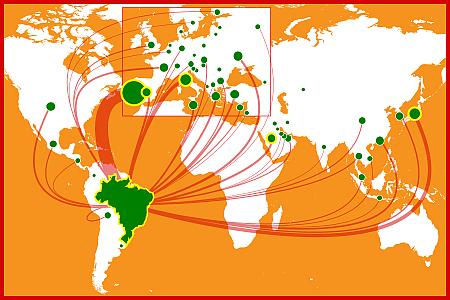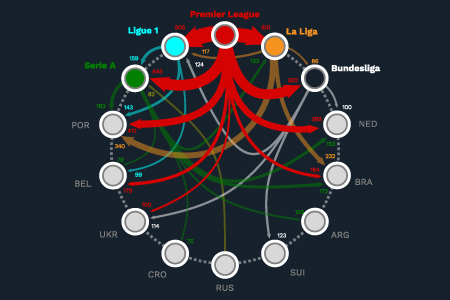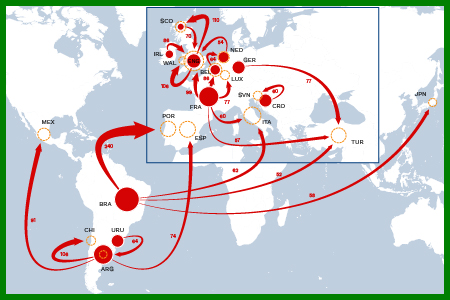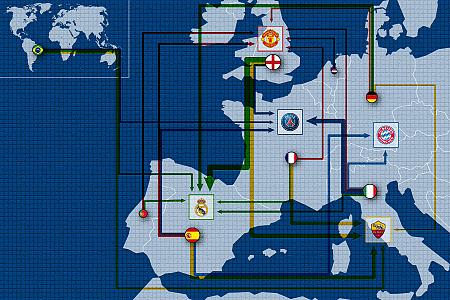This Report analyses the composition of teams participating in the five of the most developed women’s professional leagues worldwide: four European leagues (Germany, Sweden, France and England), as well as the National Women’s Soccer League in the United States. It reveals that the age of players increases, international mobility grows and the concentration of the best footballers within a limited number of clubs independently of their origin pursues its course.
Monthly Report 46
Demographic analysis of the five major women’s football leagues
Monthly Report 45
World football expatriates: global study 2019
This Monthly Report analyses the presence of expatriate footballers in 147 leagues from 98 national associations. Brazil is clearly at the top of the rankings for countries exporting footballers, ahead of France and Argentina. The most frequented migratory route originates from Brazil and ends in Portugal (261 players). England and Italy are the chief importing countries of footballers.
Monthly Report 44
Attendances in football stadia (2003-2018)
The 44th Monthly Report of the CIES Football Observatory analyses match attendances in 51 national football leagues from 42 countries. The first part focuses on 26 championships. It retraces the evolution in attendances over the last fifteen years. The second part compares the attendances recorded over the last five seasons for all of the 51 leagues included in the analysis.
Monthly Report 43
Mapping the origin of English Premier League players
This Monthly Report focuses on the top English football division: the Premier League. It analyses the evolution of the origin of players fielded over the past ten years. It shows that the percentage of players having grown up in England, the “nationals”, has progressively fallen to reach a new negative record level over the current season. The proportion of goals scored by Englishmen shows a similar trend.
Monthly Report 42
Evolution of competitive balance in the Champions League
This 42nd Monthly Report analyses the evolution of the competitive balance in the group stages of the Champions League since the introduction of the current format in 2003/04. The different indicators analysed illustrate a clear trend towards less balance and more predictability.
Monthly Report 41
How important is ball possession in football?
The 41st CIES Football Observatory Monthly Report analyses the link between ball possession and results in 35 championships from UEFA member associations using the data used generated by the specialist InStat company. Though the link between success and possession is undeniable, it is only from a certain level that ball control allows teams to improve significantly their results. This is probably the source of the erroneous but widespread idea that possession is not a key factor for success.
Monthly Report 40
Competitive balance: a spatio-temporal comparison
Competitive balance is a crucial issue for the whole of collective sports. The 40th Monthly Report of the CIES Football Observatory analyses this issue from a spatio-temporal perspective. The sample includes 24 European competitions over a period of ten seasons between 2008/09 and 2017/18. All of the indicators analysed illustrate a trend towards a greater imbalance in European football.
Monthly Report 39
Demographic analysis of the football players’ labour market in Europe
The long-term work carried out within the CIES Football Observatory focuses, in particular, on the demographic analysis of the football players’ labour market. The surveys carried out over the past decade allow us to reveal very clear trends. As illustrated in this report, the footballers’ labour market in Europe is becoming deterritorialised by a decreasing presence of club-trained players, a stronger presence of expatriate footballers and greater mobility.
Monthly Report 38
Player turnover strategies in the five major European leagues
This report analyses club strategies in the area of player turnover for the five major European leagues since 2005/06. It reveals that too many changes in line-ups do not constitute a good strategy for optimising results. On the contrary, high turnover levels tend to affect players’ confidence and aggravate the situation.
The 37th CIES Football Observatory Monthly Report analyses from a financial standpoint transfer operations carried out by big-5 league clubs since 2010. It notably highlights the key role played by the Premier League in the structuration of the market. During the eight-year period analysed, English top division clubs are responsible for 78.3% of the overall big-5 league deficit for transfer operations.
Football analytics
The CIES Football Observatory 2017/18 season
Football offers incredibly interesting possibilities to when it comes to data-driven analysis. This e-book regroups the Monthly Reports published by the CIES Football Observatory over the course of the 2017/18 season. Two research notes are also included. The contents mainly relate to our three key areas of expertise: the demography study of the players’ labour market, the analysis of the technical performance of both teams and players, as well as the economic study of the transfer market.
Monthly Report 36
Demographic analysis of five major women’s football leagues
The 36th CIES Football Observatory Monthly Report analyses the composition of squads in five major women’s leagues: four European (Germany, Sweden, France and England), as well as the Women’s National Soccer League in the United States. The study notably highlights the increases in the average age of players. The number of expatriate footballers goes also up both on the pitch and in squads.
Monthly Report 35
World football expatriates: global study 2018
The 35th edition of the CIES Football Observatory Monthly Report analyses the presence of expatriate players in the world. The sample is composed of 12,425 expatriate footballers present on the 1st of May 2018 in 2,235 teams from 142 leagues of 93 national associations. Brazil is the most represented country (1,236 expatriates), followed by France (821) and Argentina (760). The nationals from these three associations make up 22.7% of the total number of expatriates.
Monthly Report 34
The importance of squad stability: evidence from European football
The first CIES Football Observatory Monthly Report published in January 2015 studied club stability across Europe. Three years later, the thirty-fourth edition develops this issue by illustrating the value of long-term planning for football clubs. The indicator selected is the percentage of players recruited by their employer club since less than one year.
Monthly Report 33
A comparative analysis of club-trained players in Europe
The analysis of the presence of club-trained players in squads across Europe is particularly interesting when it comes to comparing football cultures and strategies on an international level. The report covers first team squad members of clubs from 31 top division European leagues. It relies on the annual census carried out by the CIES Football Observatory on the 1st of October of every year since 2009.
Monthly Report 32
Is there an optimum squad age to win in football?
The demographic analysis of squads is a key research area of the CIES Football Observatory. The 32nd edition of the Monthly Report analyses the age structure of teams in 31 top division European leagues. This allows us to show discrepancies on an international level, while also investigating the links between the age structure of teams and success.
Monthly Report 31
The transfer of footballers: a network analysis
The 31st CIES Football Observatory Monthly Report analyses transfer networks from different angles. Firstly, it studies the destinations of expatriates from the three main exporting countries: Brazil, Argentina and France. It then analyses from a historical perspective the recruitment areas of big-5 league teams. The same study is carried out at club level for Real Madrid, Manchester United, AS Rome, Bayern Munich and Paris St-Germain.
Monthly Report 30
2018 FIFA World Cup™: profile of qualified teams
The thirtieth Monthly Report of the CIES Football Observatory analyses the profile of the 32 teams that have qualified for the final phase of the 2018 FIFA World Cup™. The study covers the thematics of age, height, country of birth and employer association of players fielded by each squad during the qualifying matches.



















